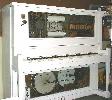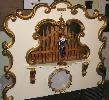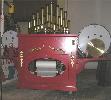 | | Coinola Orchestrion Model 610.
In the late 1800's, pneumatically controlled player piano's were enhanced to contain many other instruments,
which were automatically played to simulate a complete band. While officially called a Orchestrion, the instrument is
widely known as a 'Nickelodeon'. Orchestrion's faded into oblivion in the early
1900's due to the invention of the phonograph and radio.
This particular coin operated Orchestrion was built in the 1970's by the
Nickelodeon Piano Company of Huntsville Alabama and uses a O style paper roll spool frame produced by the Player Piano Company of
Wichita Kansas. In addition to a piano, this Orchestrion contains a Tambourine, Bells, a Xylophone, a Triangle, Wood Block,
Snare Drum, Bass Drum, Mandolin Rail and a Cymbal. All the instruments are controlled pneumatically. A single motor runs both the paper roll
reader (which control's the song notes and instruments) and a air pump. All the instruments playing together produce the pleasing,
honky tonk Nickelodeon sound.
|
Click here to view enlarged picture
Click here to listen to a short demo of the Orchestrion playing
|
 | | Savins Band Organ.
Pneumatically controlled band organs have been produced since the 1800's and used as centerpieces
for traditional Carousels as well as at fairs and even on European streets. With ornate proceniums, the
sound produced by the pipes is sweet and conducive to a circus atmosphere. Band organs have largely been
replaced by taped music in the United States, but can still be found at traditional amusement parks such
as Knoebels Grove in PA and their heritage is protected by several collector groups. This particular Band Organ
was built in Dyfed Wales, UK in 1984 by master organ builder Michael Savins. It contains 39 pipes and
has a 20 note range plus percussion with a tambourine. This organ uses 22-Keyless organ 'books' for control. These
cardboard books are punched with holes and slowly unfold with each page being used to control the organ, then
refolded on the other side. The hand carved band master in front is mechanical and he moves his baton arm
while the organ plays. After visiting some of the worlds greatest band organs at museums and the world
renown Jasper Sanfilippo collection, I began searching for my own band organ. Thanks to Phil Dayson, a mechanical
music collector and enthusiast in Vancouver, British Columbia for supplying me with this beautiful
band organ.
|
Click here to view enlarged picture
Click here to listen to a short demo of the Savins Band Organ playing
|
 | | D42R Carousel Calliope.
One of the most pleasant memories of old time circus and carousels are the ubiquitous Calliope.
Pipes of varying lengths are made to whistle via compressed air or steam producing a very airy
uniquely festive sound. The Calliope became very well known in the early part of the twentieth
century when Norman Baker created the first Tangley brand Calliope and began to produce and
market them from his shop in Muscatine Iowa. The most popular and well known of the Tangley
Calliope's was the model CA-43. This Calliope could either be played via a keyboard utilizing
up to 43 pipes or via a paper "A" roll which allowed the use of up to 41 pipes. Throughout
the years, several other companies have marketed variants of the Tangley Calliope. This particular
instrument was produced in 2000 by Kenneth Caulkin's Ragtime West Company of Ceres, California.
This Calliope has 42 pipes and plays "O" roll's of the type commonly used in Orchestrion's.
In addition to 42 pipes, this instrument also has a Bass Drum, Snare Drum,
Cymbal and Triangle all of which are also controlled from the O-Roll. This Calliope is setup to
accept quarters inorder to play a song. Thus, it is suitable for on location use in bars, dance
hall's etc. in addition to carousels and circus's.
This Calliope was obtained from the estate of Winston "Pinky" Disbrow. Mr. Disbrow owned
a camp in Copake, NY for approximately twenty years. Within the camp was a arcade with various
games for all. In addition, Mr. Disbrow loved racing and participated in the midget car racing
circuit. After his retirement, Mr. Disbrow began collecting mechanical music machines including
this beautiful instrument. Thanks to Mr. Disbrows family for allowing me to add this to my
collection and share it with visitors to this website.
|
Click here to view enlarged picture
Click here to listen to a short demo of the Calliope playing
|